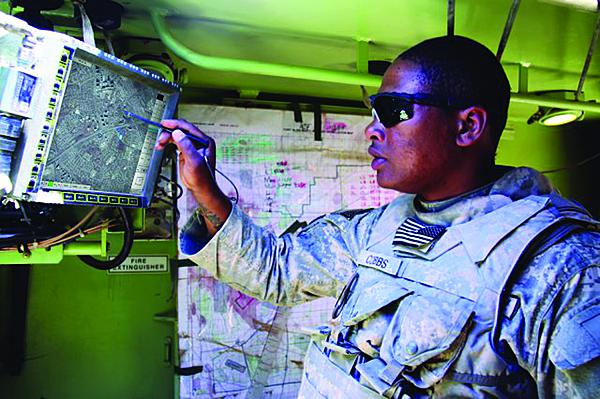Better Visibility Across the Battlefield
The U.S. Army’s system for enabling shared situational awareness to track friends or foes at the lowest tactical levels is undergoing multiple capabilities upgrades intended to increase the value of the technology. Advances include the ability to handle more data traffic, as well as better encryption, more timely reporting of position and improved navigation.
A key release for Blue Force Tracker brings new benefits to two theaters.
 |
| A Soldier from the 2nd Brigade Combat Team,1st Armored Division uses the new version of the Army's friendly force tracking and messaging software,known as Force XXI Battle Command Brigade and Below,Blue Force Tracking Joint Capabilities Release (JCR),inside his vehicle. The combat team assesses technologies during the Army's Network Integration Evaluations. The JCR has been deployed to Korea and Afghanistan. |
The U.S. Army’s system for enabling shared situational awareness to track friends or foes at the lowest tactical levels is undergoing multiple capabilities upgrades intended to increase the value of the technology. Advances include the ability to handle more data traffic, as well as better encryption, more timely reporting of position and improved navigation.
These software enhancements for the Force XXI Battle Command Brigade-and-Below/Blue Force Tracking (FBCB2/BFT) are dubbed the Joint Capabilities Release (JCR). The software uses the BFT 2 network, a new satellite infrastructure that can handle significantly more data than the first version of the tracking system, according to Jeff Forgach, chief, readiness management, Joint Battle Command–Platform (JBC-P), under the U.S. Army’s Program Executive Office Command, Control and Communications–Tactical (PEO C3T). The end state of the JCR enhancement to the FBCB2/BFT is the JBC-P.
The FBCB2/BFT provides integrated, on-the-move battle command information from brigade to platform, as well as across platforms with a brigade task force and other joint forces. According to the program executive office, the JBC-P is the next generation of the system, providing joint-centric on-the-move digital command and control and situational awareness to tactical combat, combat support and combat service support leaders and warfighters.
With the JCR, soldiers can transmit more frequent and larger message traffic. In many cases, the technology also will cut the system’s refresh rate from minutes to seconds. “This results in more timely and accurate reporting of position location information,” Forgach states. The JCR allows access to the Type 1 secret network through the KGV-72 encryption device. With the capability, users can send secret data even while on the move and can interoperate with command posts.
Maj. Gregory Johanek, USA, Eighth United States Army communication operations chief, says the encryption is the biggest difference between the previous system and the new capabilities. Soldiers in the Eighth Army in Korea received the technology first, and they already have fit more than 1,000 platforms with the upgrades, including delivery to the 2nd Infantry Division, the major ground combat unit in the Asian nation. Fielding starts this month in Afghanistan, where more than 13,000 platforms are scheduled to receive the advanced features. The JCR most benefits Eighth Army operations by increasing both the security level and protected nature of blue force tracking.
Originally, all the upgrades were scheduled for delivery to Korea in fiscal year 2013, but the Eighth Army requested the JCR delivery early to facilitate training on the advancements prior to achieving full operational capability in 2015. The organization has a requirement to use the Combined Enterprise Regional Information Exchange System Korea (CX-K) coalition network to share information with United States Forces Korea as well as the Republic of Korea Ground Component Command. “The Army granted this acceleration request in order to provide U.S. forces with enhanced command and control, imagery, messaging and position location information capabilities on the CX-K network,” Forgach explains. However, no interface exists yet between the JCR and exchange system. The PEO C3T is working on a technical solution that it will deliver and implement.
The cross-domain solution from the secret Internet protocol router network, or SIPRNET, to the information exchange system in Korea is the key to maximizing the value of this communications traffic. The JCR improves the ability to communicate overall by streamlining “the data flow by starting and ending on a classified network, instead of having to travel through a ‘filter’ that takes the information from an unclassified network to a classified one,” the major explains.
At the beginning of this year, Eighth Army transitioned from the U.S. Army Service Component for Army forces on the Korean peninsula to become an operational-level field Army headquarters with command and control responsibilities in the region. This change necessitated a number of fielding and system upgrade accelerations, including the JCR. The early fielding focuses on training soldiers for familiarity with the new equipment as quickly as possible. Expanded deployment to units in Afghanistan will not affect troops in Korea unless the former units transition to the peninsula.
The FBCB2 side of the technology also improves with the implementation of the JCR. A new map engine and enhanced navigational tools are included along with a self-descriptive situational awareness feature. By employing that tool, units can change task organization in the field, adapting their systems to changing conditions on the battlefield. The JCR also integrates other military technology into the systems it is designed to enhance. The Tactical Ground Reporting Web-based tool is co-hosted on all the JCR platforms and systems. Lower-echelon soldiers can use it to collect, share and analyze information via an interface similar to Google Earth, pictures and text. Troops can assess historical data and event analysis on their own during mission execution rather than within the command post.
Logistics will be enhanced with the capabilities release as well, an improvement that foreshadowed recent comments by Frank Kendall, the undersecretary of defense for acquisition, technology and logistics, that the logistics of leaving Afghanistan will be more complex than he previously expected and more difficult than during the end of major U.S. troop presence in Iraq. JCR-Logistics (JCR-Log) integrates FBCB2/BFT capability with the Movement Tracking System (MTS), a vehicle-based system that tracks combat support and combat service support vehicles, as well as other assets. “It offers a radio frequency identification capability to provide in-transit, real-time visibility of critical cargo,” Forgach says. “The MTS JCR-Log provides the technology necessary to communicate with and track tactical wheeled vehicles and cargo in near real time, enabling the safe and timely completion of distribution missions in support of full-spectrum operations. The upgraded capabilities result in a seamless, two-way situational awareness and message exchange between convoys and the maneuver formations to which they are delivering goods.”
In addition, soldiers will enjoy new chat function and instant-messaging capability, which Forgach says are user-friendly mechanisms to communicate in real time. “These new chat capabilities are the only ones found down at platform levels, on the move and in a secure domain environment,” he explains. “Other chat capabilities are inherently command-post-based.” Before fielding of the JCR began in Korea, the Army tested it at Network Integration Evaluation (NIE) 12.1. The NIEs are a series of soldier evaluations designed to field necessary and immediately functional network pieces more quickly. Forgach says the chat addition to the platform was well-received by soldiers in the evaluation. Units quickly adopted the capability for real-time coordination during their missions.
The numerous features added to the tracking systems already in use in Korea will enhance operations through better communications. “Soldiers will experience faster, better data exchange and collaboration on the coalition network as they integrate the new capabilities into their mission on the peninsula,” Forgach states.
In part, the Army’s focus on faster technology deployment through the NIEs made the faster fielding of the JCR’s various upgrades possible. Forgach explains that, “We were able to balance our priorities and employ a ‘crawl, walk, run’ strategy in the context of our overall fielding plans and the Army’s network modernization strategy.” The network evaluation last fall marked the crawl phase. Fielding in Korea served as the walk stage, and the Afghanistan deliveries of the JCR initiate the run phase. In addition to work by the PEO C3T, the Army G-3/5/7 LandWarNet/Mission Command Directorate, Army Materiel Command and the Communications-Electronics Life Cycle Management Command all played roles in the effective delivery of these capabilities.
Multi-disciplined teams deployed to Korea to conduct integration efforts. The enhancements will be installed on all wheeled and tracked vehicles employed by the receiving units except for tanks and Bradley fighting vehicles. The majority of platforms receiving the new capabilities are the M1151 enhanced armament carrier-modified Humvees, the M1025 armament carrier configuration Humvees, the M113 armored personnel carriers and the M577 command post vehicles. Forgach says that program personnel also are installing the JCR on some mine resistant ambush protected vehicles because of that platform’s emerging company intelligence support team, or COIST, mission.
During the fielding in Afghanistan, the multi-disciplined teams are traveling to the Operation Enduring Freedom theater to conduct integration efforts as required, Forgach states. Personnel will need to integrate the capabilities onto combat platforms acquired by units as theater-provided equipment—equipment left behind by other units formerly operating in the area.
Despite the climatic differences between Afghanistan and Korea, no alterations are necessary to employ the capabilities in one country or the other. “The BFT 2 satellite network allows connectivity in a variety of geographic locations,” Forgach explains.




Comments